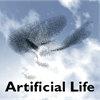Self-Reproduction and Evolution in Cellular Automata: 25 Years After Evoloops
IF 1.5
4区 计算机科学
Q4 COMPUTER SCIENCE, ARTIFICIAL INTELLIGENCE
引用次数: 0
Abstract
The year 2024 marks the 25th anniversary of the publication of evoloops, an evolutionary variant of Chris Langton’s self-reproducing loops, which proved constructively that Darwinian evolution of self-reproducing organisms by variation and natural selection is possible within deterministic cellular automata. Over the last few decades, this line of Artificial Life research has since undergone several important developments. Although it experienced a relative dormancy of activity for a while, the recent rise of interest in open-ended evolution and the success of continuous cellular automata models have brought researchers’ attention back to how to make spatiotemporal patterns self-reproduce and evolve within spatially distributed computational media. This article provides a review of the relevant literature on this topic over the past 25 years and highlights the major accomplishments made so far, the challenges being faced, and promising future research directions.细胞自动机的自我繁殖与进化:Evoloops 25 年之后
2024 年是克里斯-兰顿(Chris Langton)的自繁殖循环(self-reproducing loops)的进化变体 evoloops 发表 25 周年,它建设性地证明了在确定性细胞自动机中通过变异和自然选择实现自繁殖生物的达尔文进化是可能的。在过去的几十年里,人工生命研究经历了几个重要的发展阶段。虽然这一领域的研究活动曾一度相对沉寂,但最近人们对开放式进化的兴趣日渐浓厚,连续细胞自动机模型也取得了巨大成功,这些都让研究人员重新关注如何在空间分布式计算介质中实现时空模式的自我复制和进化。本文回顾了过去 25 年来有关这一主题的相关文献,重点介绍了迄今为止取得的主要成就、面临的挑战以及未来有希望的研究方向。
本文章由计算机程序翻译,如有差异,请以英文原文为准。
求助全文
约1分钟内获得全文
求助全文
来源期刊

Artificial Life
工程技术-计算机:理论方法
CiteScore
4.70
自引率
7.70%
发文量
38
审稿时长
>12 weeks
期刊介绍:
Artificial Life, launched in the fall of 1993, has become the unifying forum for the exchange of scientific information on the study of artificial systems that exhibit the behavioral characteristics of natural living systems, through the synthesis or simulation using computational (software), robotic (hardware), and/or physicochemical (wetware) means. Each issue features cutting-edge research on artificial life that advances the state-of-the-art of our knowledge about various aspects of living systems such as:
Artificial chemistry and the origins of life
Self-assembly, growth, and development
Self-replication and self-repair
Systems and synthetic biology
Perception, cognition, and behavior
Embodiment and enactivism
Collective behaviors of swarms
Evolutionary and ecological dynamics
Open-endedness and creativity
Social organization and cultural evolution
Societal and technological implications
Philosophy and aesthetics
Applications to biology, medicine, business, education, or entertainment.
 求助内容:
求助内容: 应助结果提醒方式:
应助结果提醒方式:


